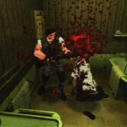The first thing to know is that the PS1 doesn't even have a depth buffer, so some degree of cleverness is required to have 3D models interacting with pre-rendered backgrounds.
The most obvious way is the break the background into multiple textures by depth, and then draw them in depth order. This is what games like the PS1 Final Fantasies do. The drawback with this method is that it can greatly increase the amount of VRAM taken up by background textures, especially on maps with complex depth structures. I think Resident Evil does something rather different though.
Now I'm not 100% certain (though it is the most likely option given those textures), but I would guess it makes use of the PS1's little-known mask mode. In 15-bit color mode - which is the only mode the PS1 can draw polygons in - the upper bit of each pixel in the frame buffer is used as a masking bit, and when masking is enabled, the GPU does not write to pixels that have their mask bit set. To facilitate this, the GPU also has a mask write mode, which sets the mask bit for pixels that are written.
Now, here's where the magic happens. That mask texture is a palletized texture, meaning it's trivial to recolor on the fly - just set the polygon to use a different color look-up table. The colors in the CLUT are also 15-bit, and again the upper bit has a special meaning, in this case the semi-transparent flag, which functions as a primitive alpha channel. Now an important quirk of the PS1 GPU is that semi-transparent black (i.e. color 0x8000) is treated as transparent regardless of the blend mode and thus isn't drawn.
So at draw time, first the background texture is drawn. Then mask writes are enabled, and, in contrast to standard PS1 rendering, the CLOSEST polygons are drawn (normal PS1 rendering is back to front). Then color writes are disabled, and the mask texture is drawn with a palette that will set the mask bit for the closest background pixels (either the bright green or the ice blue in the lower left corner). Then color writes are enabled again and the next-closest batch of polygons is drawn, and so on. Needless to say, any semi-transparent textures have to be drawn last, which is the one drawback of this method.
For the record, the way the PS1 hardware works means all those state changes are relatively cheap.
(The colors in the mask image that you see are likely just for the artist's convenience, since it's easier to distinguish the different discrete depth levels with colors like that than with a smooth gradient. The actual palettes used in-game are likely the same for all screens and so don't need to be saved with the mask itself.)










